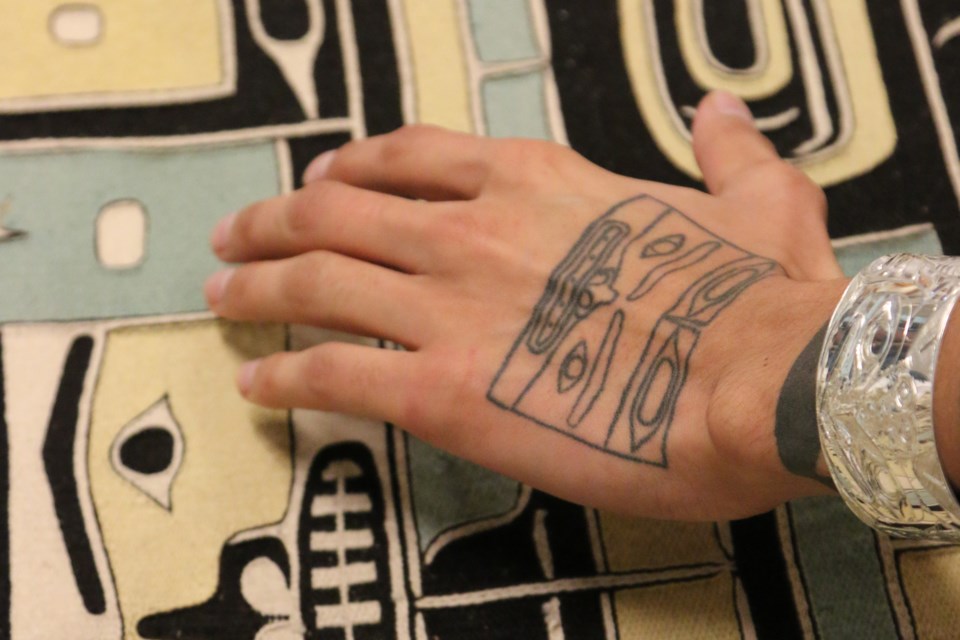DETAILS
"Body Language: Reawakening Cultural Tattooing of the Northwest"
A traveling exhibition from the Bill Reid Gallery of Northwest Coast Art
Featuring guest curators Dion Kaszas (Nlaka’pamux), Nakkita Trimble (Nisga’a), Nahaan (Tlingit), Corey Bulpitt (Haida) and Dean Hunt (Heiltsuk)
Runs until May 2 at Musée Héritage Museum
St. Albert Place (5 St. Anne St.)
Call 780-459-1528 or visit museeheritage.ca for more information.
When it comes to cultural identity, a tattoo is a prominent and permanent way of making your mark. Say what you will about a lot of the ink that gets indelibly scratched onto people’s skin, there is much to learn and more to appreciate about the body art of the Pacific Northwest Coastal Indigenous peoples. To them, it’s a symbol of place, clan and spirituality, all rolled into one.
Musée Héritage Museum curator Joanne White said she is excited about "Body Language," and not just because it’s the first new exhibit since "Keeping the Peace," which opened at the end of January.
“With the popularity of tattooing right now, I thought it would be a really great idea for people to learn about the origins of some of our tattooing and the different global cultures and what they do – in this particular case, it's the Northwest Coast – but to really understand why tattooing originated and what it means when you go to get a tattoo,” she explained.
For a display like this, one that is so invested in Indigenous cultures so far removed from a landlocked mid-Alberta suburb, it was imperative that the Musée rely on the Bill Reid Gallery of Northwest Coast Art and its five guest curators who are tattoo artists themselves.
These five – Dion Kaszas (Nlaka’pamux), Nakkita Trimble (Nisga’a), Nahaan (Tlingit), Corey Bulpitt (Haida), and Dean Hunt (Heiltsuk) – work to reclaim their tattoo traditions.
"We believe you are open to the spirit world when being tattooed and that you must protect your spirit in that ceremony," explained Trimble in a prepared statement.
"Symbolically, the tattoo was just one vessel within many vessels: the skin, the clothing, regalia and even the clan house, both physically and spiritually. Each represented a layer of the Haida cosmos and your place within it," Bulpitt continued in the statement.
Tattooing, White elaborated, was a big part of the potlatch. People would gather together and get their clan crests tattooed on them. At least that was the case, until the federal government banned potlatches 135 years ago as an amendment to the Indian Act. The ban lasted until 1951.
“Tattooing really was stopped in 1885. The younger generation is now reclaiming some of those designs and symbols and meanings and using it for personal expression but also for healing and then regaining that cultural tradition.”
When the practices of tattooing and potlatches were banned, people began to put their personal crests on clothing and jewellery.
"Indigenous tattooing and piercing are deeply connected to the struggle and triumphs of Indigenous peoples,” said guest curator Dion Kaszas, a Hungarian, Métis and Nlaka’pamux tattoo artist, painter and cultural tattoo practitioner.
“Having a physical ancestral mark helps to instil pride as we make ourselves visible as the original peoples of this land. It is also significant for many – particularly those who are displaced – on their journey of self-discovery and understanding of what it means to be Indigenous”.
The exhibit includes historic tattoos as well as photographs of the five artists, plus the sculptures, masks, and paintings that each submitted.




